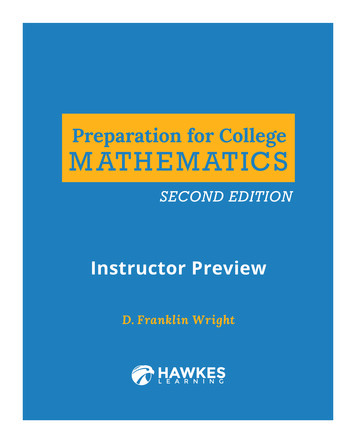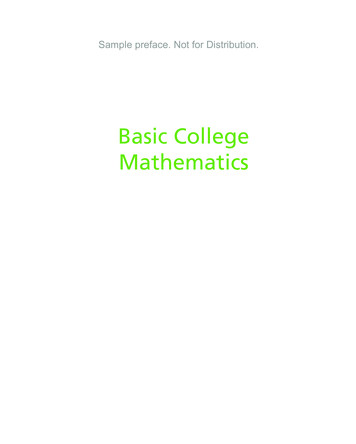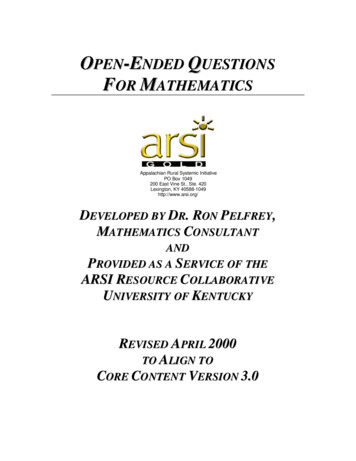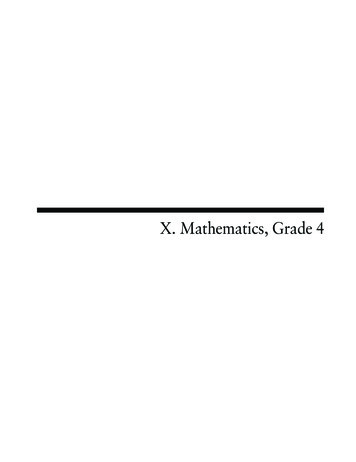
Transcription
Preparation for CollegeM ATH E MATICSSECOND EDITIONInstructor PreviewD. Franklin WrightPCM Marketing Booklet.indb 110/11/2017 9:57:45 AM
Editor: Nina WaldronWIEProject Manager: Patrick Vande BosscheYLNOAssistant Editors: Chelsey Cooke, S. Rebecca Johnson, Barbara MillerVEDesigners: D. Kanthi, E. Jeevan Kumar, U. Nagesh, James Smalls,Patrick Thompson, Tee Jay ZajacRRCover Design: Patrick Thompson and Tee Jay ZajacOFVP Research & Development: Marcel PrevuznakDirector of Content: Kara RochéA division of Quant Systems, Inc.FORRVEWIEYLNO546 Long Point Road, Mount Pleasant, SC 29464Copyright 2017 by Hawkes Learning / Quant Systems, Inc. All rights reserved.No part of this publication may be reproduced, stored in a retrieval system, or transmitted in any form or by any means,electronic, mechanical, photocopying, recording, or otherwise, without the prior written consent of the publisher.Printed in the United States of AmericaISBN: 978-1-946158-70-3PCM Marketing Booklet.indb 210/11/2017 9:57:45 AM
Instructor Sample ContentsPreparation for College Mathematics Second Edition Table of Contents. . . . . . . . . . . . . . . . . . . . . . . . . . vPreparation for College Mathematics: Content Highlights . . . . . . . . . . . . . . . . . . . . . . . . . . . . . . . . . . . . . ixYLNStrategies for Academic SuccessHow to Read a Math Textbook. . . . . . . . . . . . . . . . . . . . . . . . . . . . . . . . . . . . . . . . . . . . . . . . . . . . . . . . . . . . 1Tips for Success in a Math Course. . . . . . . . . . . . . . . . . . . . . . . . . . . . . . . . . . . . . . . . . . . . . . . . . . . . . . . . . 2OTips for Improving Math Test Scores. . . . . . . . . . . . . . . . . . . . . . . . . . . . . . . . . . . . . . . . . . . . . . . . . . . . . . . 3WIEPractice, Patience, and Persistence! . . . . . . . . . . . . . . . . . . . . . . . . . . . . . . . . . . . . . . . . . . . . . . . . . . . . . . . 4Note Taking. . . . . . . . . . . . . . . . . . . . . . . . . . . . . . . . . . . . . . . . . . . . . . . . . . . . . . . . . . . . . . . . . . . . . . . . . . . . 5VEDo I Need a Math Tutor?. . . . . . . . . . . . . . . . . . . . . . . . . . . . . . . . . . . . . . . . . . . . . . . . . . . . . . . . . . . . . . . . . 6Tips for Improving Your Memory. . . . . . . . . . . . . . . . . . . . . . . . . . . . . . . . . . . . . . . . . . . . . . . . . . . . . . . . . . 7RROvercoming Anxiety. . . . . . . . . . . . . . . . . . . . . . . . . . . . . . . . . . . . . . . . . . . . . . . . . . . . . . . . . . . . . . . . . . . . . 8Online Resources. . . . . . . . . . . . . . . . . . . . . . . . . . . . . . . . . . . . . . . . . . . . . . . . . . . . . . . . . . . . . . . . . . . . . . . 9OFPreparing for a Final Math Exam. . . . . . . . . . . . . . . . . . . . . . . . . . . . . . . . . . . . . . . . . . . . . . . . . . . . . . . . 10Chapter ProjectYLNOTake Me Out to the Ball Game!. . . . . . . . . . . . . . . . . . . . . . . . . . . . . . . . . . . . . . . . . . . . . . . . . . . . . . . . . . 12CHAPTER 2IntegersWIE2.1 Introduction to Integers. . . . . . . . . . . . . . . . . . . . . . . . . . . . . . . . . . . . . . . . . . . . . . . . . . . . . . . . . . . . 13VE2.2 Addition with Integers . . . . . . . . . . . . . . . . . . . . . . . . . . . . . . . . . . . . . . . . . . . . . . . . . . . . . . . . . . . . . 22RR2.3 Subtraction with Integers. . . . . . . . . . . . . . . . . . . . . . . . . . . . . . . . . . . . . . . . . . . . . . . . . . . . . . . . . . . 31CHAPTER 8FOGraphing Linear Equations and Inequalities8.1 The Cartesian Coordinate System. . . . . . . . . . . . . . . . . . . . . . . . . . . . . . . . . . . . . . . . . . . . . . . . . . . . 418.2 Graphing Linear Equations in Two Variables . . . . . . . . . . . . . . . . . . . . . . . . . . . . . . . . . . . . . . . . . . 588.3 Slope‑Intercept Form . . . . . . . . . . . . . . . . . . . . . . . . . . . . . . . . . . . . . . . . . . . . . . . . . . . . . . . . . . . . . . 68CHAPTER 15Exponential and Logarithmic Functions15.3 Exponential Functions . . . . . . . . . . . . . . . . . . . . . . . . . . . . . . . . . . . . . . . . . . . . . . . . . . . . . . . . . . . . 8415.4 Logarithmic Functions . . . . . . . . . . . . . . . . . . . . . . . . . . . . . . . . . . . . . . . . . . . . . . . . . . . . . . . . . . . . 97PCM 2e Preface.indd 310/11/2017 12:35:15 PM
WIEVERROFFOPCM Marketing Booklet.indb 4OVERRYLNWIEYLNO10/11/2017 9:57:45 AM
Preparation for College Mathematics Second Edition Table of ContentsvPrefacePreparation for College Mathematics Second Edition Table of Contents Note: Content subject to changeCHAPTER 1CHAPTER 3Whole NumbersFractions, Mixed Numbers,and ProportionsYLN1.1Introduction to Whole Numbers1.2Addition and Subtractionwith Whole Numbers1.3Multiplication with Whole Numbers3.2Multiplication with Fractions1.4Division with Whole Numbers3.3Division with Fractions1.5Rounding and Estimatingwith Whole Numbers3.4Multiplication and Divisionwith Mixed Numbers1.6Problem Solving with Whole Numbers3.5Least Common Multiple (LCM)1.7Solving Equations with WholeNumbers (x b c and ax c)3.6Addition and Subtraction with Fractions3.7Addition and Subtractionwith Mixed Numbers3.8Comparisons and Order ofOperations with Fractions3.9Solving Equations with FractionsWIEVERROFO3.11.8Exponents and Order of Operations1.9Tests for Divisibility1.10 Prime Numbers and Prime FactorizationsIntroduction to Fractionsand Mixed NumbersCHAPTER 23.10 Ratios and RatesIntegers3.11 ProportionsWIE3.12 Probability2.1Introduction to Integers2.2Addition with Integers2.3Subtraction with Integers2.4Multiplication, Division, and Orderof Operations with Integers2.5VEFORRYLNOCHAPTER 4Decimal Numbers4.1Introduction to Decimal NumbersSimplifying and Evaluating Expressions4.22.6Translating English Phrasesand Algebraic ExpressionsAddition and Subtractionwith Decimal Numbers4.32.7Solving Equations with Integers (ax b c)Multiplication and Divisionwith Decimal Numbers4.4Estimating and Order of Operationswith Decimal Numbers4.5Statistics: Mean, Median, Mode, and Range4.6Decimal Numbers and Fractions4.7Solving Equations with Decimal NumbersPCM Marketing Booklet.indb 510/11/2017 9:57:46 AM
viPrefacePreparation for College Mathematics Second Edition Table of ContentsCHAPTER 5CHAPTER 7PercentsSolving Linear Equationsand Inequalities5.1Basics of Percent5.2Solving Percent ProblemsUsing Proportions7.1Properties of Real Numbers7.2Solving Linear Equations:x b c and ax c5.3Solving Percent Problems Using Equations5.4Applications of Percent7.3Solving Linear Equations: ax b c5.5Simple and Compound Interest7.4Solving Linear Equations: ax b cx d5.6Reading Graphs7.5Working with Formulas7.6Applications: Number Problemsand Consecutive IntegersCHAPTER 6WIEMeasurement and GeometryVE6.1US Measurements6.2The Metric System: Length and Area6.3The Metric System: Weight and Volume6.4US and Metric Equivalents6.5Angles and Triangles6.6Perimeter6.7Area6.8Volume and Surface Area6.9Similar and Congruent TrianglesRROFO7.7Applications: Distance-Rate-Time,Interest, Average, and Cost7.8Solving Linear Inequalities7.9Compound Inequalities7.10 Absolute Value Equations7.11 Absolute Value InequalitiesCHAPTER 8YLNOGraphing Linear Equationsand Inequalities6.10 Square Roots and thePythagorean Theorem8.1The Cartesian Coordinate System8.2Graphing Linear Equationsin Two VariablesVEFOWIE8.3Slope-Intercept Form8.4Point-Slope Form8.5Introduction to Functionsand Function Notation8.6Graphing Linear Inequalitiesin Two VariablesRRPCM Marketing Booklet.indb 6YLN10/11/2017 9:57:46 AM
Preparation for College Mathematics Second Edition Table of ContentsviiPrefaceCHAPTER 9CHAPTER 11Systems of Linear EquationsFactoring Polynomials9.1Systems of Linear Equations:Solutions by Graphing11.1 Greatest Common Factor (GCF)and Factoring by Grouping9.2Systems of Linear Equations:Solutions by Substitution11.2 Factoring Trinomials: x2 bx c11.3 Factoring Trinomials: ax2 bx c9.3Systems of Linear Equations:Solutions by Addition11.4 Special Factoring Techniques9.4Applications: Distance-Rate-Time,Number Problems, Amounts, and Costs11.6 Solving Quadratic Equations by Factoring9.5Applications: Interest and Mixture9.6Systems of Linear Equations:Three Variables9.7Matrices and Gaussian EliminationRational Expressions9.8Systems of Linear Inequalities12.1 Introduction to Rational ExpressionsWIECHAPTER 1212.2 Multiplication and Divisionwith Rational Expressions12.3 Least Common Multiple of PolynomialsExponents and PolynomialsOF10.2 Power Rules for Exponents12.5 Simplifying Complex Fractions10.3 Applications: Scientific Notation12.6 Solving Rational Equations10.4 Introduction to Polynomials10.5 Addition and Subtraction with Polynomials10.6 Multiplication with PolynomialsRRFOPCM Marketing Booklet.indb 712.7 Applications: Rational ExpressionsWIE12.8 Applications: VariationVE10.7 Special Products of Binomials10.9 Synthetic Division and theRemainder TheoremYLNO12.4 Addition and Subtraction withRational Expressions10.1 Rules for Exponents10.8 Division with PolynomialsO11.7 Applications: Quadratic EquationsVERRCHAPTER 10YLN11.5 Review of Factoring Techniques10/11/2017 9:57:46 AM
viiiPrefacePreparation for College Mathematics Second Edition Table of ContentsCHAPTER 13CHAPTER 15Roots and Radicals13.1 Evaluating RadicalsExponential andLogarithmic Functions13.2 Simplifying Radicals15.1 Algebra of Functions13.3 Rational Exponents15.2 Composition of Functionsand Inverse Functions13.4 Addition, Subtraction, andMultiplication with RadicalsYLN15.3 Exponential Functions13.5 Rationalizing Denominators15.4 Logarithmic Functions13.6 Solving Radical Equations15.5 Properties of Logarithms13.7 Functions with Radicals15.6 Common Logarithms andNatural Logarithms13.8 Introduction to Complex Numbers13.9 Multiplication and Divisionwith Complex NumbersCHAPTER 14VERRQuadratic Equations14.1 Quadratic Equations: TheSquare Root MethodOFWIEO15.7 Logarithmic and ExponentialEquations and Change-of-Base15.8 Applications: Exponential andLogarithmic FunctionsCHAPTER 16Conic SectionsYLNO14.2 Quadratic Equations:Completing the Square16.1 Translations and Reflections14.3 Quadratic Equations: TheQuadratic Formula16.3 Distance Formula, MidpointFormula, and Circles14.4 More Applications of Quadratic Equations16.4 Ellipses and Hyperbolas14.5 Equations in Quadratic Form16.5 Nonlinear Systems of Equations16.2 Parabolas as Conic SectionsVE14.6 Graphing Quadratic Functions14.7 More on Graphing Functionsand Applications14.8 Solving Polynomial andRational InequalitiesFORRPCM Marketing Booklet.indb 8WIE10/11/2017 9:57:46 AM
Preparation for College Mathematics: Content HighlightsPrefaceixPreparation for College Mathematics:Content HighlightsNew FeaturesStrategies for Academic SuccessChapter ProjectsA new section has been included to help studentshone their skills in note taking, time management, testtaking, and reading. This section also provides tipsfor improving memory, overcoming test anxiety, andfinding a math tutor. (See page 19 for more)This new feature promotes collaboration and showsstudents the practical side of mathematics throughactivities using real-world applications of the conceptstaught in the chapter. (See page 27 for more)Strategies for Academic Success Taking notes in class is an important step in understanding new material. While there are several methods for takingnotes, every note-taking method can benefit from these general tips.General TipsExample: Write the date and the course name at the top ofeach page. Write the notes in your own words and paraphrase. Use abbreviations, such as ft for foot, # for number,def for definition, and RHS for right-hand side. Copy all figures or examples that are presentedduring the lecture. Review and rewrite your notes after class. Do thison the same day, if possible.Keywords:RatiosRROFThere are many different methods of note taking and it’salways good to explore new methods. A good time to tryout new note-taking methods is when you rewrite yourclass notes. Be sure to try each new method a few timesbefore deciding which works best for you. Below are threenote-taking methods you can try out. You may even findthat a blend of several methods works best for you.Note-Taking MethodsOutlineAn outline consists of several topic headings, eachfollowed by a series of indented bullet points that includesubtopics, definitions, examples, and other details.Notes:1. Comparison of twoquantities by divisiona2.3.b, a : b, a to bCan reduce4. Common units can cancelSummary: Ratios are used to compare quantitiesand units can cancel.OMappingThe mapping method is the most visual of the threemethods. One common way to create a mapping isto write the main idea or topic in the center and drawlines, from the main idea to smaller ideas or subtopics.Additional branches can be created from the subtopicsuntil all of the key ideas and definitions are included.Using a different color for subtopic can help visuallyorganize the topics.Example:Comparison of quantities by divisionCan bereduceda to baba:bThe split page method divides the page vertically into twocolumns with the left column narrower than the rightcolumn. Main topics go in the left column and detailedcomments go in the right column. The bottom of the pageis reserved for a short summary of the material covered.1.Find two other note taking methods anddescribe them.2.Write five additional abbreviations that youcould use while taking notes.An activity to demonstrate the use of percents and percent of increase or decrease in real life.Round all percents to the nearest whole percent.1. The Atlanta-Fulton County Stadium had aseating capacity of 52,769 fans. Turner Field hada seating capacity of 50,096. SunTrust Park has aseating capacity of 41,149.5. Chipper Jones, a popular Braves third baseman,retired in July 2013. He started his career withthe Braves in 1993 at the age of 21.a. Determine the amount of decrease in seatingcapacity between Turner Field and theoriginal Braves stadiuma. In 2001, Chipper had 189 hits in 572at-bats. Calculate Chipper’s batting averagefor the season by dividing the number ofhits by the number of at-bats. Round to3 decimal places.3. When Turner Field opened in 1997, theaverage attendance at an Atlanta Braves gamewas 42,771. In 2016 the average attendancewas 24,950. What is the percent decrease inattendance from 1997 to 2016?QuestionsSplit PageTake Me Out to the Ball Game!The Atlanta Braves baseball team has been one of the most popular baseball teams for fans not only from Georgia, butthroughout the Carolinas and the southeastern United States. The Braves franchise started playing at the Atlanta-FultonCounty Stadium in 1966 and this continued to be their home field for 30 years. In 1996, the Centennial Olympic Stadium thatwas built for the 1996 Summer Olympics was converted to a new ballpark for the Atlanta Braves. The ballpark was namedTurner Field and was opened for play in 1997. In 2017, the braves moved to a new stadium named SunTrust Park.2. The Centennial Olympic Stadium hadapproximately 85,000 seats. Some of the seatingwas removed in order to convert it to the TurnerField ballpark. Rounding the number of seats inTurner Field to the nearest thousand, what is theapproximate percent decrease in seating capacityfrom the original Olympic stadium?Main TopicCommon unitscancelChapter Projectb. Determine the percent decrease in seatingcapacity between SunTrust Park andTurner field.RatiosExample:1. Ratioa. Comparison of two quantities by division.b. Ratio of a to bai.bii. a : biii. a to bc. Can be reducedd. Common units can cancelWIEVENote TakingYLNSource: baseball-almanac.com4. The highest average attendance for the Braveswas 47,960 in 1993 at the Atlanta-FoultonCounty Stadium. The Lowest average attendancewas 6642 in 1975 at the Atlanta-Foulton CountyStadium. What is the percent increase from thelowest attendance to the highest?Source: baseball-almanac.comNew exercises to assess students’ conceptual understanding of topics and important definitions areincluded in every section.VERRFO1. The sum of the lengths of the sides of apolygon is its .PCM Marketing Booklet.indb 9WIEApplicationsConcept CheckSource: espn.go.comb. In 2008, Chipper had 160 hits in 439at-bats. Calculate Chipper’s batting averagefor the season by dividing the number ofhits by the number of at-bats. Round to3 decimal places.YLNOc. Calculate the percent change in Chipper’sbatting average from 2001 to 2008.d. Does this represent a percent increaseor decrease?6. In 2001, Chipper had 102 RBIs (runs batted in).In 2008, Chipper had only 75 RBIs.a. Calculate the percent change in RBIs from2001 to 2008.b. Does this represent a percent increase ordecrease?Additional real-world application problems have beenadded throughout the text to challenge students toapply the concepts taught in the lesson.Extra MaterialAdditional, more advanced topics have been added toprovide students with a text that fully prepares them forfuture college mathematics courses.10/11/2017 9:57:47 AM
xPrefacePreparation for College Mathematics: Content HighlightsAdditional FeaturesMath at WorkMargin ExercisesEach chapter begins with a brief discussion related to aconcept developed in the coming material and includesquestions students will solve later in the chapter tosolidify their knowledge and understanding.Each example has a corresponding margin exerciseto test students’ understanding of what was taught inthe example.YLN1. Solve: 3x 4 7ObjectivesThe objectives provide students with a clear andconcise list of the main concepts and methods taught ineach section, enabling students to focus their time andeffort on the most important topics. Objectives havecorresponding labels located in the section text wherethe topic is introduced for ease of reference.A. Multiply fractions.VEB. Reduce fractions to lowestterms.OFNotesWIERRObjectives1. x 1ONotes boxes in the margin point out important information that will help deepen student understanding ofthe topics. Often these are helpful hints about subtledetails in the definitions that many students do notnotice upon first glance.NotesGreek mathematician Euclid isoften referred to as the ‘Father ofGeometry’ for his revolutionaryideas and influential textbookcalled Elements that he wrotearound the year 300 BC.C. Multiply and reduce fractionsto lowest terms.A First objectiveExamplesExamples are denoted with titled headers indicating theproblem-solving skill being presented. Each sectioncontains carefully explained examples with appropriatetables, diagrams, and graphs. Examples are presentedin an easy-to-understand, step‑by‑step fashion andannotated with notes for additional clarification.Solution6 8 6 8 48 7 5 7 5 35VEStraightforward definitions are presented in highlyvisible boxes for easy reference.RRFOExample 1 Multiplying Fractions6 8Multiply: 7 5WIEDefinition BoxesYLNOAlgebraThe branch of mathematics that deals withgeneral statements of relations, utilizing lettersand other symbols to represent specific setsof numbers, values, vectors, and so on, in thedescription of such relations.DEFINITIONNow work margin exercise 1.PCM Marketing Booklet.indb 1010/11/2017 9:57:49 AM
Preparation for College Mathematics: Content HighlightsxiPrefaceCommon ErrorsIndex of Key Ideas and TermsThese hard-to-miss boxes highlight common mistakesand how to avoid them.Each chapter contains an index highlighting themain concepts within the chapter. This summarygives complete definitions and concise steps to solveparticular types of problems.CautionChapter TestsDon’t forget to carry the 1!CalculatorsFor visual learners, key strokes and screenshots areprovided when appropriate for visual reference. Wealso provide step‑by‑step instructions for using asimple four‑function calculator for more basic operations, as well as a TI-84 Plus for graphing skills.Located in the back of the book, the answer keyprovides answers to all odd numbered exercises in eachsection, as well as all answers to the exercises in thechapter tests. This allows students to check their workto ensure that they are accurately applying the methodsand skills they have learned.VEPerforming a task with a calculatorPress the keys .Then press .OFOAnswer KeyWIERRǞǞ CALCULATORSYLNEach chapter includes a chapter test that providesan opportunity for the students to practice the skillspresented in the chapter in a test format.The display will read 1738.ExercisesEach section includes a variety of exercises to givethe students much-needed practice applying andreinforcing the skills they learned in the section. Theexercises progress from relatively easy problems tomore difficult problems.Writing and ThinkingVEFORRWIEYLNOThis feature gives students an opportunity to independently explore and expand on concepts presented in thechapter. These questions foster a better understandingof the concepts learned within each section.Collaborative LearningThis feature encourages students to work with othersto further explore and apply concepts learned in thechapter. These questions help students realize that theysee many mathematical concepts in the world aroundthem every day.PCM Marketing Booklet.indb 1110/11/2017 9:57:49 AM
xii WIEVERROFFOPCM Marketing Booklet.indb 12OVERRYLNWIEYLNO10/11/2017 9:57:49 AM
How to Read a Math Textbook1Strategies for Academic SuccessStrategies for Academic Success How to Read a Math TextbookReading a textbook is very different than reading a book for fun. You have to concentrate more on what you are readingbecause you will likely be tested on the content. Reading a math textbook requires a different approach than readingliterature or history textbooks because the math textbook contains a lot of symbols and formulas in addition to words.Here are some tips to help you successfully read a math textbook.YLNDon’t Skim Use Available ResourcesWhen reading math textbooks, look at everything: titles,learning objectives, definitions, formulas, text in themargins, and any text that is highlighted, outlined, or inbold. Also pay close attention to any tables, figures, charts,and graphs.Many textbooks have companion websites to help youunderstand the content. These resources may containvideos that help explain more complex steps or concepts.Try searching the internet for additional explanations oftopics you don’t understand.Minimize DistractionsRead the Material Before ClassWIEOReading a math textbook requires much moreconcentration than a novel by your favorite author, sopick a study environment with few distractions and a timewhen you are most attentive.Try to read the material from your book before theinstructor lectures on it. After the lecture, reread thesection again to help you retain the information as youlook over your class notes. Start at the BeginningUnderstand the MathematicalDefinitions VERRDon’t start in the middle of an assigned section. Mathtends to build on previously learned concepts and youmay miss an important concept or formula that is crucialto understanding the rest of the material in the section.OFHighlight and AnnotatePut your book to good use and don’t be afraid to addcomments and highlighting. If you don’t understandsomething in the text, reread it a couple of times. If it isstill not clear, note the text with a question mark or someother notation so you can ask your instructor about it.Go through Each Step ofEach Example RRFOWrite down important definitions, symbols or notation,properties, formulas, theorems, and procedures. Reviewthese daily as you do your homework and before takingquizzes and tests. Practice rewriting definitions in yourown words so you understand them better.WIEYLNOTry Reading the Material AloudVEMake sure you understand each step of an example. Ifyou don’t understand something, mark it so you can askabout it in class. Sometimes math textbooks leave outintermediate steps to save space. Try working through theexamples on your own, filling in any missing steps.Take Notes This is important!Many terms used in everyday English have a differentmeaning when used in mathematics. Some examplesinclude equivalent, similar, average, median, and product.Two equations can be equivalent to one another withoutbeing equal. An average can be computed mathematicallyin several ways. It is important to note these differencesin meaning in your notebook along with importantdefinitions and formulas.Reading aloud makes you focus on every word in thesentence. Leaving out a word in a sentence or mathproblem could give it a totally different meaning, so besure to read the text carefully and reread, if necessary.Questions1.Explain how taking notes can help youunderstand new concepts and skills whilereading a math textbook.2.Think of two more tips for reading a mathtextbook.Notes 9-25-17:- The opposite of a negative integer is a positive integer.- T o add tow integers with the same signs add theirabsolute values and use their common signStudy Skills.indd 110/17/2017 12:38:42 PM
2Strategies for Academic SuccessTips for Success in a Math CourseStrategies for Academic Success Tips for Success in a Math CourseRead Your Textbook/Workbook Do Your HomeworkOne of the most important skills when taking a mathclass is knowing how to read a math textbook. Reading asection before class and then reading it again afterwardsis an important strategy for success in a math course. Ifyou don’t have time to read the entire assigned section,you can get an overview by reading the introduction orsummary and looking at section objectives, headings, andvocabulary terms.When doing homework, always allow plenty of timeto finish it before it is due. Check your answers whenpossible to make sure they are correct. With word orapplication problems, always review your answer to seeif it appears reasonable. Use the estimation techniquesthat you have learned to determine if your answermakes sense.Take Notes VERRReviewWhile the information is fresh in your mind, read throughyour notes as soon as possible after class to makesure they are readable, write down any questions youhave, and fill in any gaps. Mark any information that isincomplete so that you can get it from the textbook oryour instructor later.OFOUnderstand, Don’t MemorizeWIETake notes in class using a method that works for you.There are many different note-taking strategies, such asthe Cornell Method and Concept Mapping. You can tryresearching these and other methods to see if they mightwork better than your current note-taking system.YLNDon’t try to memorize formulas or theorems withoutunderstanding them. Try describing or explaining themin your own words or look for patterns in formulas soyou don’t have to memorize them. For example, youdon’t need to memorize every perimeter formula if youunderstand that perimeter is equal to the sum of thelengths of the sides of the figure.StudyPlan to study two to three hours outside of class for everyhour spent in class. If math is your most difficult subject,then study while you are alert and fresh. Pick a study timewhen you will have the least interruptions or distractionsso that you can concentrate.YLNO Stay Organized Manage Your TimeAs you review your notes each day, be sure to label themusing categories such as definition, theorem, formula,example, and procedure. Try highlighting each categorywith a different colored highlighter.Don’t spend more than 10 to 15 minutes working on asingle problem. If you can’t figure out the answer, put itaside and work on another one. You may learn somethingfrom the next problem that will help you with the oneyou couldn’t do. Mark the problems that you skip so thatyou can ask your instructor about it during the next class.It may also help to work a similar, but perhaps easier,problem.Use Study AidsFOPractice, Practice, Practice!Math is like playing a sport. You can’t improve yourbasketball skills if you don’t practice—the same is trueof math. Math can’t be learned by only watching yourinstructor work through problems; you have to be activelyinvolved in doing the math yourself. Work through theexamples in the book, do some practice exercises atthe end of the section or chapter, and keep up withhomework assignments on a daily basis.Study Skills.indd 2VERRUse note cards to help you remember definitions,theorems, formulas, or procedures. Use the front of thecard for the vocabulary term, theorem name, formulaname, or procedure description. Write the definition, thetheorem, the formula, or the procedure on the back of thecard, along with a description in your own words.WIEQuestions1.Based on your schedule, what are thebest times and places for you to study forthis class?2.Describe your method of taking notes. Listtwo ways to improve your method.10/11/2017 1:20:11 PM
Tips for Improving Math Test Scores3Strategies for A
2.2 Addition with Integers 2.3 Subtraction with Integers 2.4 Multiplication, Division, and Order of Operations with Integers 2.5 Simplifying and Evaluating Expressions 2.6 Translating English Phrases and Algebraic Expressions 2.7 Solving Equations with Integers (ax b











